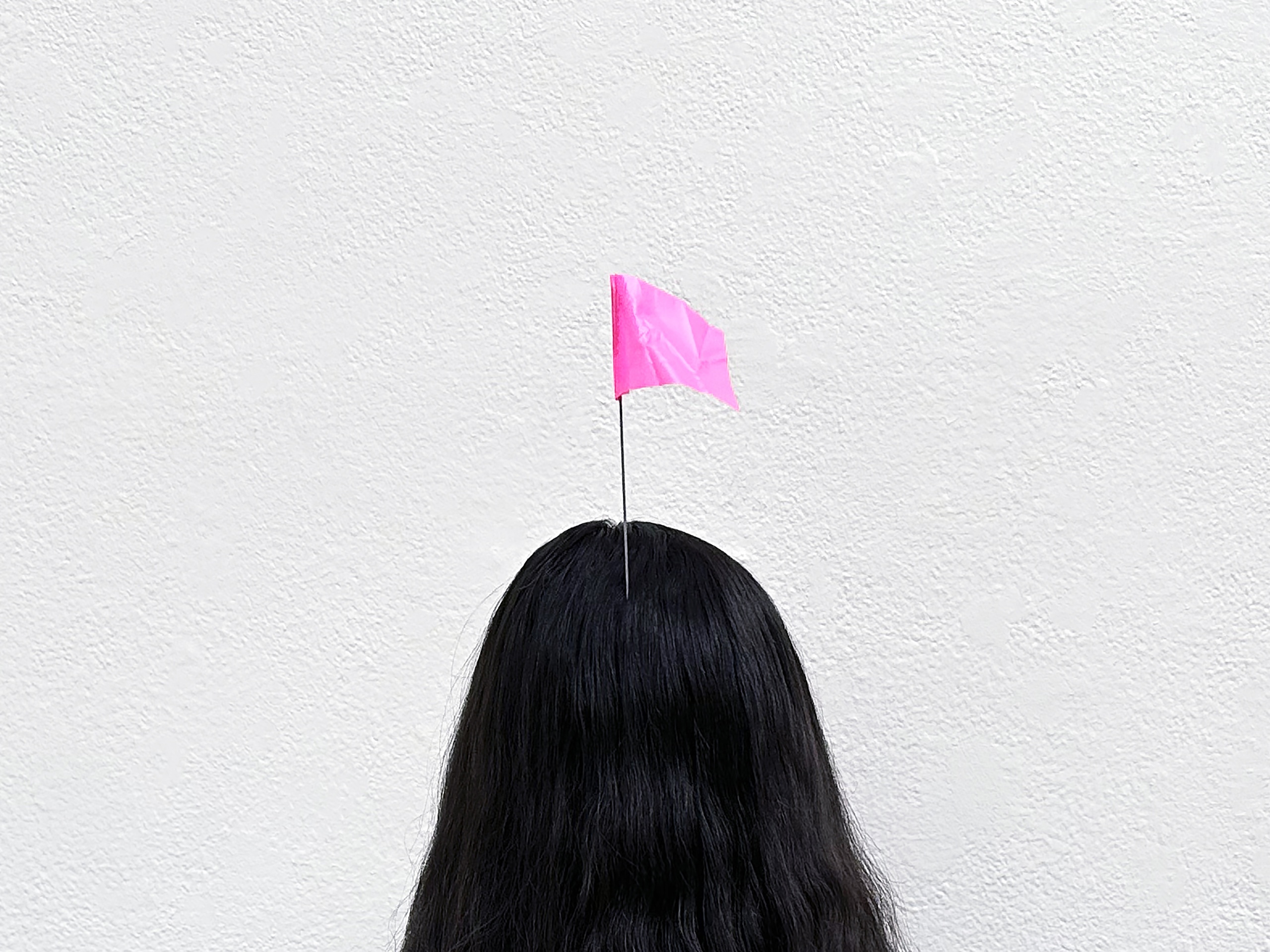The Feminist Interview Project, organized by CAA’s Committee on Women in the Arts, examines the practices of feminism by interviewing a range of scholars and artists. The project aims to preserve the living histories of feminist art practices, while interrogating and expanding the boundaries of what might be considered feminist. Throughout its interviews, this project reimagines the possibilities of feminist practice and feminist futures by exploring a diversity of perspectives and approaches to research. This collection of interviews aspires to critically examine the relationships between feminism, feminist art, and the lived realities of women, nonbinary and female-identified artists and scholars across the globe. For our ongoing collaboration with Art Journal Open, the Feminist Interview Project is excited to present artist Natani Notah in conversation with art historian and curator Elizabeth S. Hawley. The two met for a conversation over Zoom on July 18, 2025.
Elizabeth S. Hawley: I’m speaking with Natani Notah, whose practice, in her words, “explores contemporary Native American existence through the lens of Indigenous Feminism.”1 We have much to discuss. Natani, may I ask you to introduce yourself in your own words for the AJO readers?
Natani Notah: Yáʼátʼééh, hello everyone, my name is Natani Notah, I’m a Diné (Navajo) visual artist and educator currently based in Tulsa, Oklahoma. I was born in San Bernardino, California, with ties to the Navajo Nation and CRIT in Parker, Arizona, so the Southwest is very important to me and who I am.2 I’m happy to be talking with you today, thank you for this opportunity.
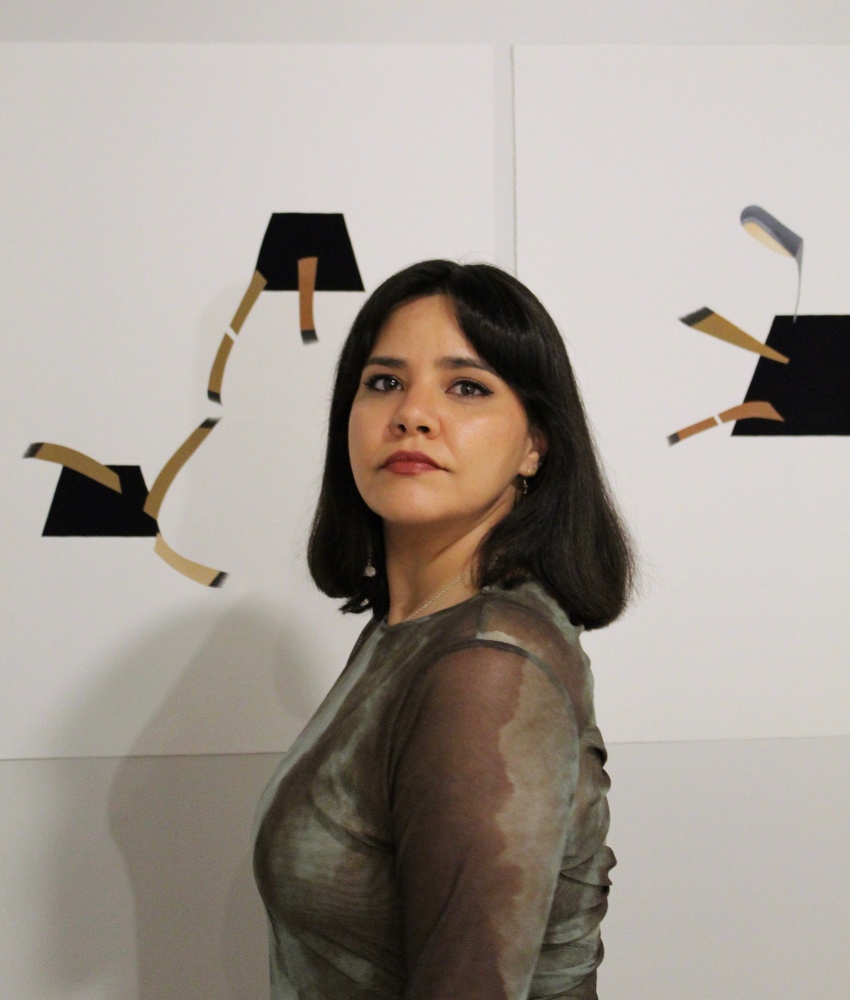
Natani Notah (photography by Kashona Notah; image provided by the artist) 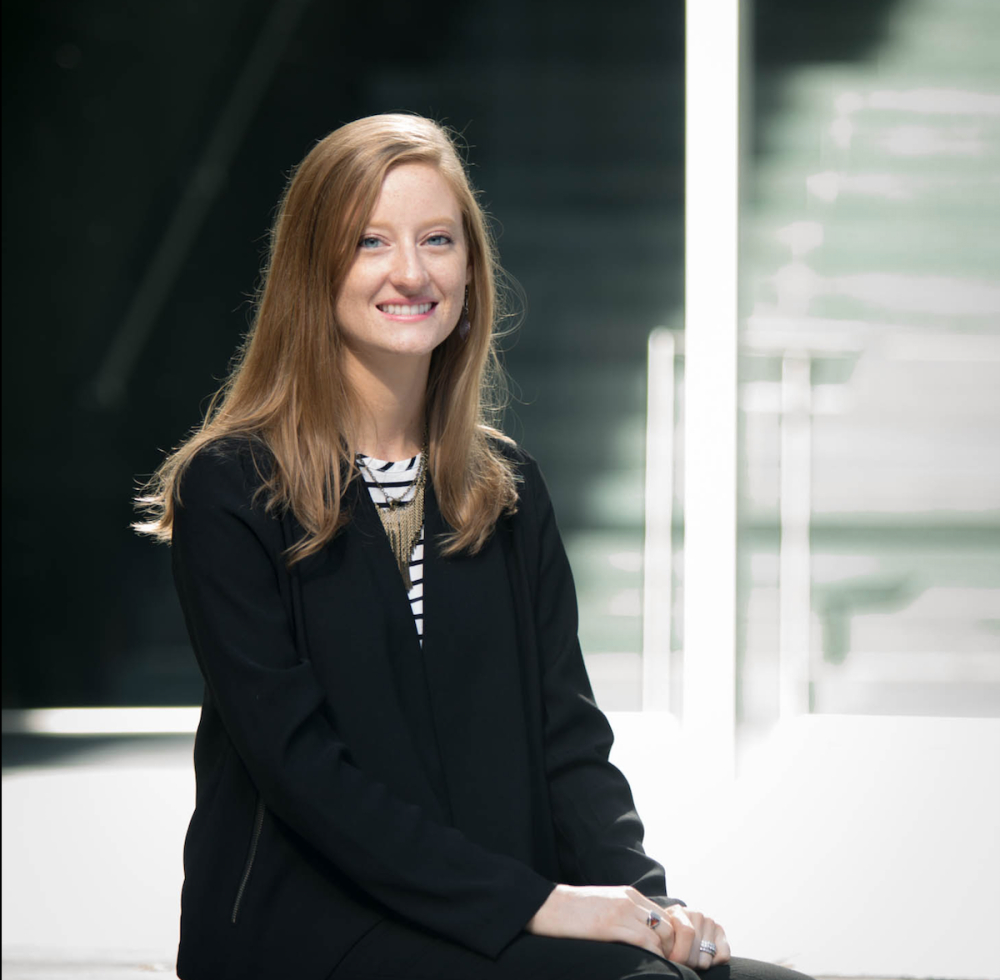
Elizabeth Hawley (photograph provided by the author)
ESH: Great, thank you for being here. I’m going to start with our foundational Feminist Interview Project question: What is feminism to you?
NN: My definition of feminism has evolved over the years, but the heart of it has remained the same—that feminism is believing in and advocating for women’s rights on the basis of sex and gender equality. I consider myself a Diné, Native, Indigenous, or Woman of Color Feminist as well, and with that comes additional factors that influence how I navigate feminism. What I have to protect and continually fight for, alongside others who also face more challenges attached to their existence, is often heavier and more complex. As a Native woman, I’m often coming into the room, having to educate people first, to remind them that Native people still exist despite this country’s genocidal history. Remind them that we are humans too and we deserve respect. Often that’s where I have to start before a conversation about equality can even begin.
That’s what drew me to feminism and intersectionality in the first place though. I appreciated how feminism is forever evolving, it’s an ongoing movement. One could also argue that most Native nations or matrilineal societies embodied these ideals long before the word feminism was coined. So, I’m inherently and deeply invested in this topic.
ESH: This reminds me of Paula Gunn Allen’s phrase, the “red roots of white feminism,” which I’ve always found such a compelling, succinct way of explaining that these ideas that were later termed feminism are inherent in many Indigenous worldviews.3
NN: Yeah, Paula Gunn Allen is a big inspiration. It also makes me think of the book Critically Sovereign, which has a lot of messaging around this topic and how these issues are connected.4
ESH: Let’s consider a couple of your recent works, Just the Tip and Funny Forms of PDA. Your works on paper always have so many details to unpack. Perhaps we can start by discussing these sharp, limb-like elements that appear in many of your recent works.
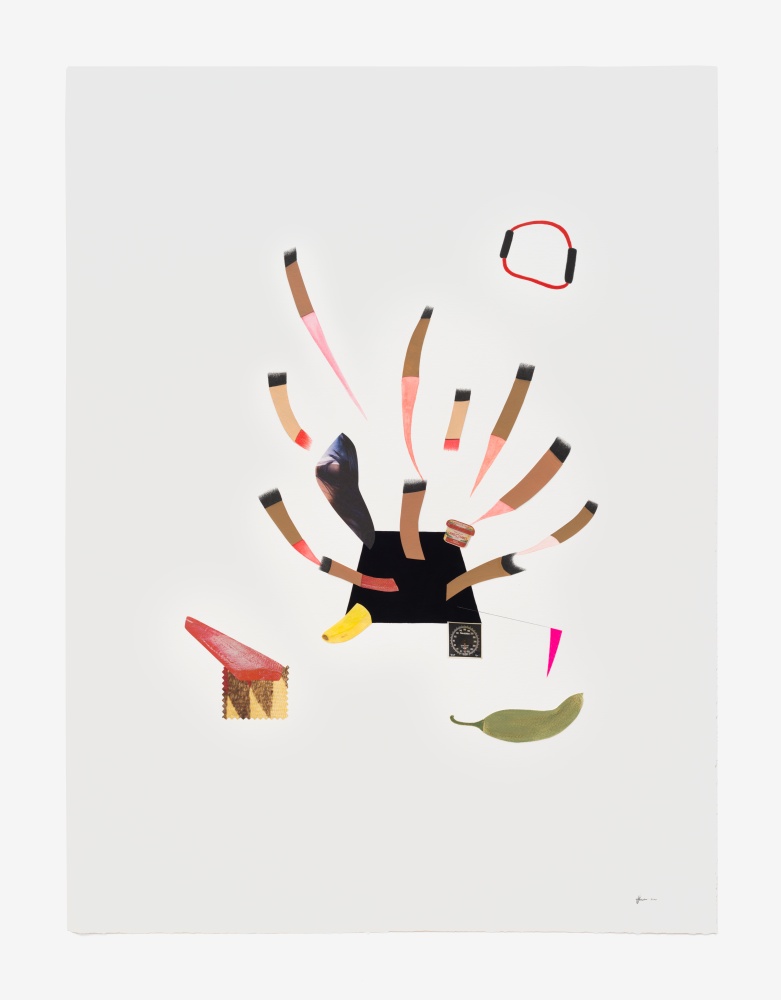
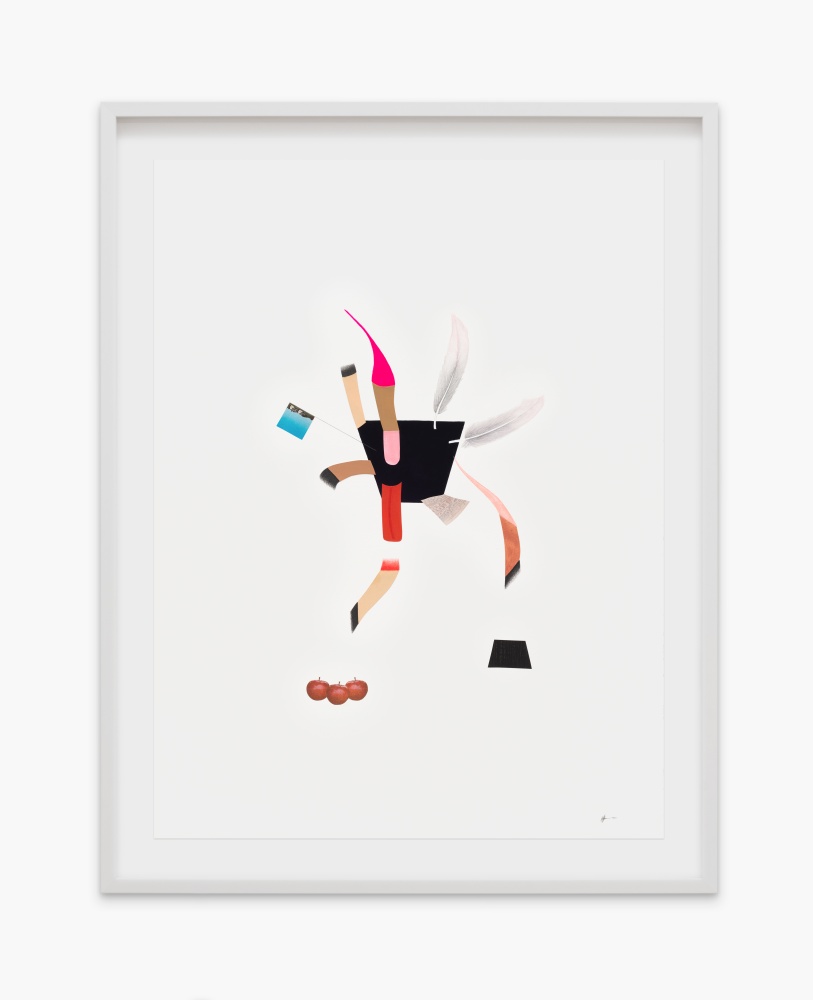
NN: I’m developing my own visual lexicon and these limb-like forms have been prominent. The ideas for them stem from the soft sculpture practice I started back in 2019. I was interested in using abstraction to explore and depict otherness, out of body experiences, feelings of dissociation, and disfigurement resulting from trauma—emotional, physical, and historical. With the mixed media works on paper, I see some of these research interests peeking through, but the repeating limb-like elements are starting to do something else. In the past, I’ve referred to them as “furry” or “disembodied” limbs. They’re hard to define, which is intentional. They are in some ways defiant, they kind of push back, and are almost anti-definition, which is very political.
I used to get frustrated by them. I was always being asked, “What are these things? Are they creatures or what?” The closest I got to pinpointing it was comparing them to the Addams Family character Thing.5 I love how Thing is this disembodied hand that’s still able to operate, move, and emote, as if they still have a brain and a heart—they are living and part of a family too, a kind of quiet hero. For me, they are a symbol of survival. So, to bring it back to my own work, ultimately, I see these limb-like beings as an extension of me, and as symbols of survival. They are very much alive; they are touching, flying, bending, diving, and floating. They are their own thing and I have simply been the one to give them the space to exist and breathe.
ESH: You often talk about your works as these entities that exist because of you, but also have their own identities. Can you speak more about that?
NN: Yeah, I think a lot about them in relation to my body. They feel almost like children, like I’ve given birth to them. And then once they’re out in the world and being shown, it’s like they’re leaving the nest, and I have to let them go and do the good work.
ESH: I’m looking at Funny Forms of PDA here—are these feathers?
NN: Yeah, in the top right corner are two feathers emerging out of this void. I try to be spare with feathers because I want to push back on connotations of feathers always being associated with Native people. But I also have a right to work with them. And feathers are important—symbolically and culturally.
Those voids keep repeating in my work too, and I’ve defined them in the past as pools, portals, or puddles. Or doorways, trapdoors—almost like a Pandora’s box where it’s been opened and these things have been unleashed. I’m also thinking about Navajo creation stories and this kind of emergence from the earth with connections to different worlds, such as the spirit world. But I’m also interested in the idea that one thing can be read as multiple things, or the possibility that it can transform into something else depending on who’s looking at it and what they’re bringing to the table.
ESH: You talked about developing a visual lexicon, and you will often call back to previous works in later works. Can you talk about the significance of that?
NN: Yeah, I’m a big believer in one work leading to another work. Or one idea leading to a whole series of works. So, this through line is important, also for me to better understand the work or the body of work. It also makes it easier for the work to then communicate, especially with these works on paper. They can exist on their own, but they become stronger when they’re next to another one, and you can visually jump from one into the other. It’s this world building and expansion that’s happening. I think about that with the sculptural work as it relates to the works on paper, as it relates to photographs, or an installation of all those things—how are they communicating with each other? How are they helping each other? And then how does that help the viewer to better understand it or have these touch points where they can enter and exit the work?
ESH: Looking at your entire creative output, you really are a multimedia practitioner—you’ve worked with performance, film/video, photography, installation, found objects—but most of your recent works tend to be works on paper and soft sculptures. What is it about these mediums that currently works so well for your artistic agenda?
NN: I started out as a painter and printmaker, then while I was in graduate school I focused on sculpture, performance, and the intersections of these through forms of documentation—photography, video, and object installation. Then a series of artist fellowships provided the time, space, and resources to expand my art practice. I was able to slow down and ask myself what I really wanted to make. If deadlines and others’ expectations were not a factor, what would I want to focus on? I was called back to my roots, and I wanted to paint, draw, assemble, and play. I started making these mixed media works on paper, which are composed of watercolors, acrylics, graphite, gouache, ink, and collaged elements. It felt like a full circle movement that grounded me and helped me to assess where I was and where I wanted to take my art next. I was reminded why I fell in love with making art in the first place. There is this freedom to these newer works. They are more abstract and harder to define, which is exciting to me and feels very feminist. I’m giving myself permission to make what I want, and explore artistic movements that have been male dominated for decades—abstraction, Surrealism, Minimalism—and this is sort of the whole point. I’m a Native woman, drawing upon my lived experiences, interests, and innermost voice, to imagine and develop a unique visual vocabulary and build an alternate world that questions everything. That sounds pretty feminist to me.
ESH: Sounds pretty feminist to me too, and I’m glad you bring up narratives of modernism where abstraction was couched in gendered male terms that glossed over entire histories of abstraction in terms of women’s and Indigenous art practices. The way that these are being brought back to the fore in your work, and in the work of others, acknowledging these histories that are there and important and should be highlighted, is so fantastic.
NN: Yeah, Native people, we’ve been doing abstraction and design for forever, that’s embedded in a lot of the work.
ESH: You’ve started to develop some extremely large works on paper. And I’m thinking about how this kind of environmental size was couched in masculine terms in the twentieth century.
NN: Yeah, I’ve recently decided to start scaling up. The works that we were just talking about are 22 by 30 inches, a standard cut of watercolor paper. The feedback I’ve been getting has been positive about the work, then there’s usually a question of, “Oh, have you thought of scaling up?” Or, “Oh, I like this so much! I would want to see even more of this world, this universe that you’re creating.” So, I got a larger roll of the same paper and slowly but surely I’m scaling up. It’s bigger than I’ve ever worked. They feel monumental. By scaling up, I’m continuing to push myself and push the work. But I’ve also been cautious with this because it feels like more of a Western way of thinking—more, more, give us more. Go bigger. I try to find the balance in all of it.
ESH: You also don’t produce huge, monumental sculptures. You describe them as being almost limb-like, and they tend to be about that size. Let’s talk about C-section, and the process of making this soft sculpture.
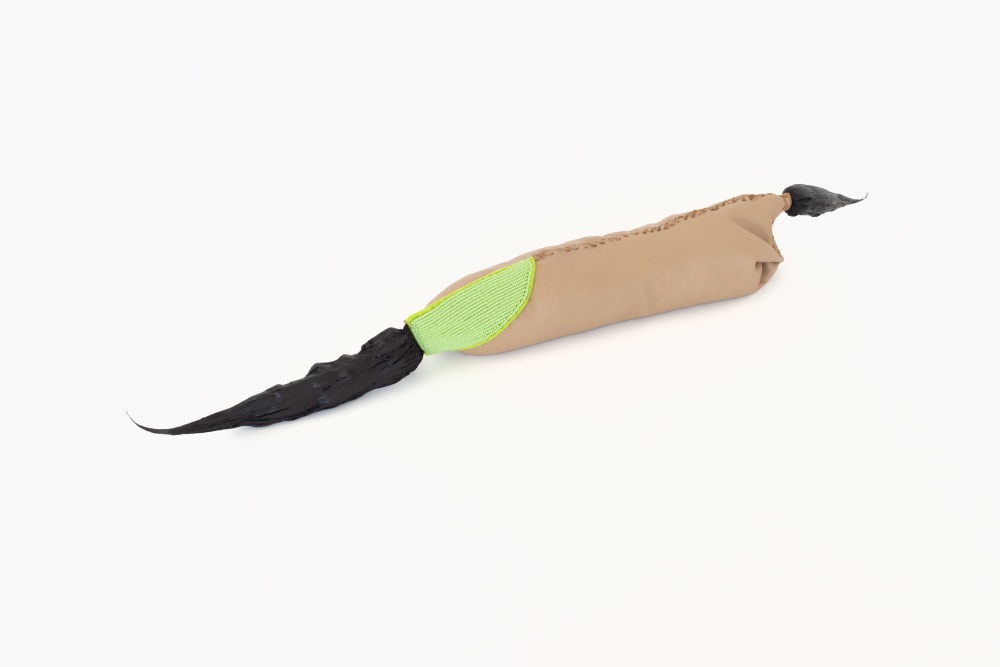
NN: Yeah. C-section is from 2022. A lot had happened in that year. Roe v. Wade was overturned, and Oklahoma was considered a trigger state.6 It immediately became illegal to have an abortion. A lot was happening politically, and I was using my artwork to respond.
Also, my nephew was born via emergency C-section and it made me think about my sister, and how brave and strong she had to be to go through that. I was also thinking of complications that can arise from pregnancy and the healthcare system, and asking how is that connected to these larger conversations about reproductive rights and women’s health? And this sculpture became a way of processing and responding. It’s also another way to point towards these larger, nationwide, and even international conversations that are still taking place—as they should be. We need to be talking about prioritizing women’s health and wellness and the right to bodily autonomy.
ESH: The beaded portion of this work is this light green color. It’s not the kind of visceral red that might evoke a C-section surgery. Can you tell me about your selection of the hue here?
NN: For me, green was this representation of life. I was thinking of the greenery of plants, and new life—a kind of growing and reproducing, and how that can occur at such a rapid rate for something like moss, or grass. But I was relating it to this idea, too, of the potential of infection, maybe happening after heavy operations. There’s this duality of it being a representation of life, but also maybe infection or something like gangrene. And, like you said, it is not what is necessarily expected, and raises these other questions of, “Oh, what is that? What does that represent, or does it mean something else?” I quite liked that. And I’m really invested in beadwork, too.
ESH: Yeah, beadwork has been so important for your practice; it appears in C-section and so many of your soft sculptures. How did you come to beading, and what has it meant for you and your work?
NN: Definitely, beadwork has been an important part of my life since I was a little kid. I remember seeing family members, including my dad making jewelry and regalia. One of my first beaded pairs of earrings were actually ones that he made me—they have blue and red beads with silver wires. I also grew up going to community events that had beading workshops. The first thing I made was a round rosette or medallion. I used blue, black, and yellow seed beads, and it’s funny because it was all lumpy, kind of messed up, but I felt proud of it because it was the first thing I ever made.
Then when I got older, I wanted to take beading more seriously, so my big sister helped me out. She pulled out her collection of beads and we sat around the kitchen table, and she showed me how to get started again. She also shared some of her tips and tricks on how to keep the beadwork flat or how to tie things off correctly. So that’s really when I took off with it and started to incorporate it into my sculptures. I went abstract with it and then very minimal. I now find myself really interested in monochromatic beadwork, like the green patch in C-section. And, as I mentioned, I made that sculpture in response to a lot of things that were going on connected to my sister.
ESH: It’s interesting to hear that your dad made jewelry. This speaks to how Indigenous practices that might be coded masculine and feminine in some contexts don’t typically have such rigid parameters; there is such fluidity. Certainly, historically, this was very difficult to grasp for colonial and settler forces. And a Native man making jewelry and beading is just a microcosmic example of that.
NN: Yeah, my dad would never have called himself a feminist, I don’t think. But he was such a good dad, and so supportive, and always affirmed in me that I was smart, and I was strong, and I was capable. And that’s a very Diné philosophy. Navajo people are matrilineal. Women have such important roles within community, and they’re respected in ways that are actually representative of what feminism is kind of fighting for. My dad was a really important person in my life, and I appreciate him having raised me.
ESH: Thanks for sharing that. What an incredible figure to have in your life.
Having talked about your works on paper and soft sculpture, I want to follow up with a consideration of a recent work that is a bit of an outlier—the photograph Intellectual Property. Visually, it is so simple—a white background against which viewers see the back of your head, with a small pink flag seemingly inserted. It is so jarring, and to me, the imagery paired with this title conjures up notions of intellectual colonialism and the dismissal of Native worldviews. But I’m more interested to hear how you view it, and how this piece came to be.
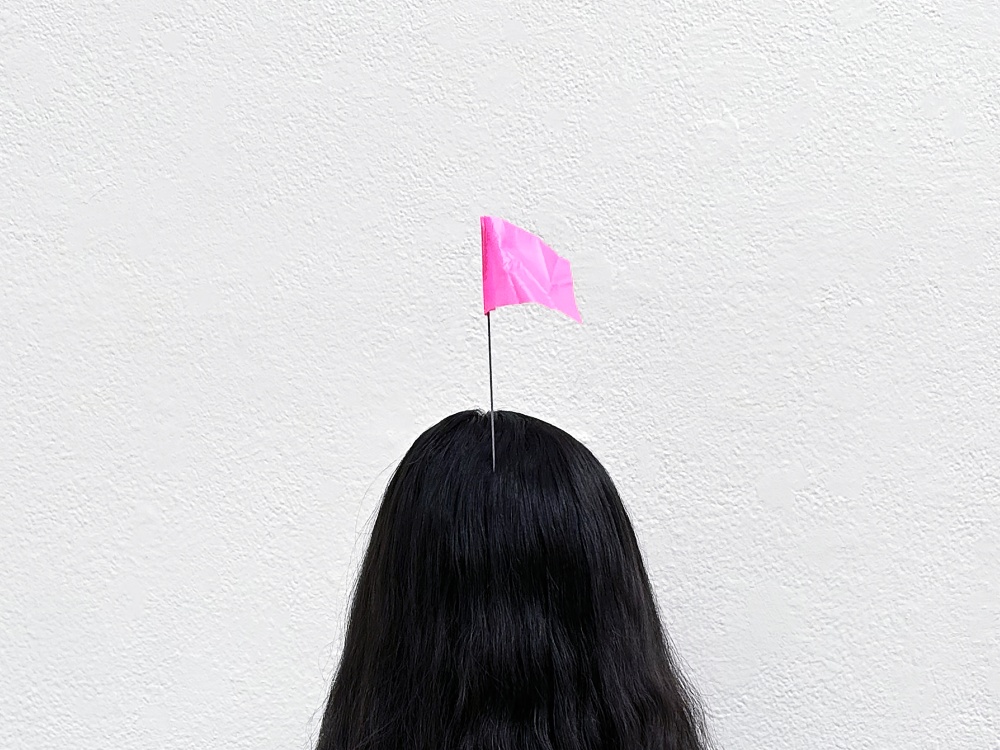
NN: Yes, this photograph is deceptively simple, but it says a lot. I made it after a really violating experience, where my name, bio, tribal affiliation, artist statement, and photographs of my artwork were used, without my permission, by an institution to apply for a large NEA grant that was ultimately awarded. It significantly benefited the institution but did not benefit me. I felt so hurt by this, like they took everything from me; my intellectual property was stolen, and I couldn’t really do much about it. I made this work in response. It made me think about the history of these lands being taken away from Native people in this country, then the resources on that land being extracted, and how Native people themselves were seen as a resource to extract from.
The original version of this photo is my full body, and was titled Staking a Claim (2023), which was powerful in many ways, and I might eventually show it. But this cropping in to focus on the head really got at what I was trying to communicate. For me, the back of the head also reads like a mound, mountain, or ant hill. It becomes somewhat uncanny, and the landscaping flag pierces through. It’s an optical illusion, but it’s like a needle; the image makes me squirm a bit. The placement also conjures up references to a feather placed in one’s hair too. As for the background, it is an institutional white wall, which is very fitting, and visually relates to the negative space of the extra white paper I use in my mixed media works.
ESH: Wow. I think we could spend an entire interview talking about your experience leading to this work, and the layered associations here.
NN: Yeah. I try to be careful about what I share and how much I disclose, thinking about the pushback, or—bringing it back to feathers—ruffling feathers. But I’m trying to share the basic facts of what happened that led me to using my art to respond to an injustice. And I’m not the only one in the field that something like this has happened to. It’s an example of a systemic problem, and it’s more prevalent than we like to imagine it is. But the silver lining of the situation—a way to turn it positive, or make it generative, or heal from it—is that I was able to make this. And I think it’s a really powerful image, and will lead to other things.
ESH: I’m interested in the language you use around not revealing too much about the original circumstance. There’s a visual resonance of this in your recent work, where you’ve moved in this direction of really abstracting the body. You’ve talked about how colonial and settler forces viewed bodies of land and bodies of Indigenous peoples as resources to be extracted from. So, the bodily refusal here seems to take on significance. Is that something that you’re thinking about?
NN: Definitely. With this work I chose to turn away from the camera. My back is literally turned to the camera, but also symbolically to the situation—like I’m making the decision to walk away. But there is also the feeling that the institution had turned their back on me, how there was no consultation. Here, I’m saying, “I’m not going to give you everything, and that’s a choice I can make.” I felt empowered by it. This work is not easily consumed, and in that way, it is defiant, and it pushes back, and it is maybe hard for some people to access. And that’s okay; it’s by design. And that’s intentional, and that is powerful. I think a lot about how I can make the work stand in for me but protect me simultaneously.
ESH: In many ways this piece is related to the work that you’ve produced that references Missing and Murdered Indigenous Women.7 I understand this is a reference for your recent work Hook, Line, and Sink Her, as well as Me Three, and it is something that has informed a number of your works. Mainstream awareness of the catastrophically high rates of violence experienced by Native women and other Relatives remains low, and the work you and other artists and activists are doing to highlight this crisis and counter the silence around it, is so important. It’s such a tender topic though, and I’m wondering if you would talk about how you choose to approach it in your artwork.
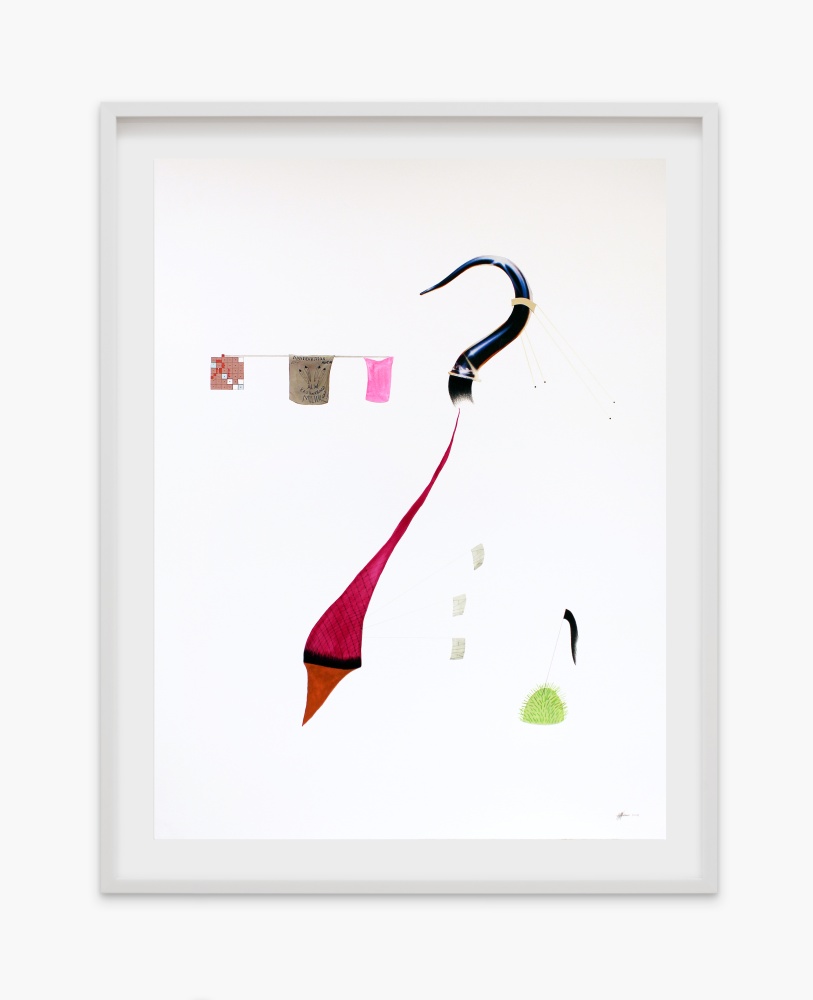
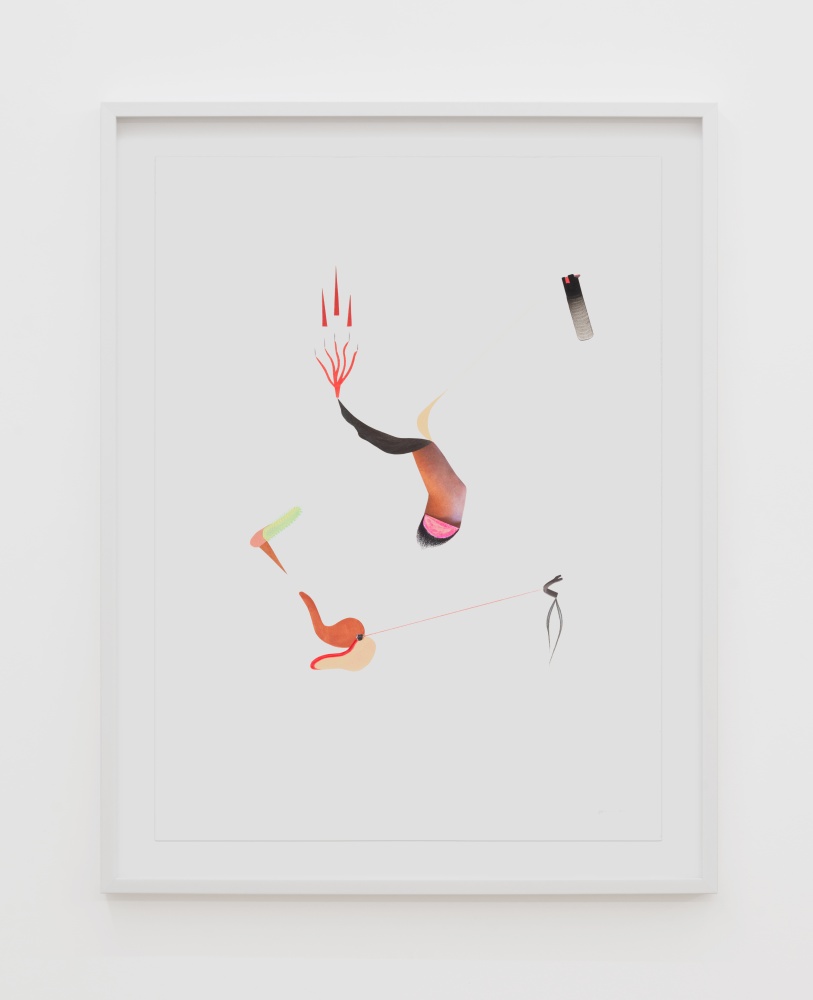
NN: You’re right, it is such a tender topic, but important to talk about too. I don’t know a Native person that hasn’t been impacted by this in some way, whether personally, or they have a family member, friend, or a friend of a friend that they know that has gone missing or been murdered. Then there are the higher rates of violence towards Native people that the mainstream media doesn’t really want to talk about. So often Native people and communities must take it upon themselves to get the word out and search not only for their loved one, but also for justice. So, in Native circles or on our social media is where we can stay informed or where we can generate awareness. I also think about how artwork is a way to process these stories. What comes to mind is the powerful work of Tanaya Winder and her travelling earring exhibition Sing Our Rivers Red, which does this so well.
And as for my own work, Hook, Line, and Sink Her, as well as Me Three loosely make references to these issues, but I always want to be careful to not perpetuate the thing I’m critiquing. It’s not my goal to depict more violence through my work, but rather point towards it, like, hey, “me three!” which is also referencing the #MeToo movement.8
I was asking, “How do I add to the conversation? How do I add to the profound work that is already being done?” A subtle way I can go about doing that is through titling. With Hook, Line, and Sink Her, I was thinking about the phrase “hook, line, and sinker,” and how it’s used to indicate that someone has been deceived or tricked, like they fell for something. And I decided to play with the words and turned “sinker” into “Sink Her.” Whether meant metaphorically or physically.
ESH: With Hook, Line, and Sink Her, I also think of fishing. And I then think of rivers, and how many Relatives have been found in bodies of water. Again, you portray it in a way that is so abstract, and it’s not what could very easily be an exploitative kind of representative imagery.
NN: Yeah, the words “hook, line, and sink her,” are connected to ideas of fishing and bodies of water, and it made me think of other works I’ve done in the past where I used fishing line, ropes, and hooks, and created sculptures that were thinking about dragging rivers. Why that’s done, and how that’s applied to cases of missing Relatives. This piece felt connected to that, but it could also just be an empty hook.
ESH: So much to unpack here, and much of it coming out of the title. An aspect of your work that I always appreciate is the language you employ; the terms and phrases you use in your artwork titles and exhibition titles you’ve selected for solo shows are so evocative. Would you explain that process, and how language is a part of your practice?
I think part of the role of my artistic practice is to also question the limitations of feminism and build new pathways for it to be more relevant to not just myself, but for others too.
NN: Similar to mixing media, I like to play with language. I’m a fan of double entendres, sly puns, and play on words. I’ve come up with every solo exhibition title I’ve had, and those are derived from my own writing. There’s a poetics to titling that adds another layer of meaning. I haven’t always considered my writing to be anything special or necessarily related to my art, but when I was an undergraduate, I had a sculpture professor ask me if I wrote. I told him I had a sketchbook that I jotted down ideas, words, and phrases in, and shared it with him. He encouraged me to keep writing and incorporate it into my work more. He told me that my writing—he called it poetry—was powerful, disarming, and unique. That it was important. That meant a lot to me—to be told that my voice and words mattered, even the ones that were not fully formed, the phrases that made you laugh or made you wonder if you should laugh, the ideas or lines that are too hard to say out loud but can lay so beautifully on the page.
I’ve carried that with me, and I take my writing seriously now. There are all these instances where language has made the work stronger and, in some ways, more accessible. With my abstracted work, I’m helping you out with an Easter egg, a clue, or a reference point via language. But I also let you build off it or add your own associations.
ESH: The titles can be really funny. I’ll return to the first work we discussed, Just the Tip. We didn’t even get into the title of this piece. How did this titling happen, and I’ll tie in a broader question: what comes first, the work or the words?
NN: Sometimes the work happens and then the title comes when it’s done. Sometimes I’ll make the work, and maybe it will be halfway or some percentage done, and all of a sudden something will click, and I’ll realize that’s the title. But then there are also moments where I’ll reference my sketchbooks and my journals, and even a Notes app I have with a list of potential titles. In those cases, titling comes first, and the piece appears whenever it wants to. It tells me what it wants to be.
“Just the tip” is a double entendre, a commonly understood innuendo. But I was also thinking about the phrase “the tip of the iceberg.” I was potentially thinking about titling it Just the Tip of the Iceberg. But I shortened it to Just the Tip to draw upon the crude humor or joke.
Titles are important. I try to use them as an opportunity to communicate. And sometimes people look at the work first, and then they go to the title and have this Aha! moment—and sometimes it’s the reverse, which can be interesting. Ultimately the work has to stand alone, and the title is like a cherry on top. And I really have fun with that. It’s another form of creative outlet.
ESH: Bringing our discussion back to one of our standard Feminist Interview Project questions: What is the ultimate relationship between feminism and your artistic practice?
NN: They are in a symbiotic relationship, where one informs the other, and vice versa. I think part of the role of my artistic practice is to also question the limitations of feminism and build new pathways for it to be more relevant to not just myself, but for others too. But again, one relies on the other, and props it up so it can have a leg to stand on.
ESH: Are there feminist artists who have influenced your work or your thinking about what it means to be a feminist?
NN: I’m currently reading Art Monsters: Unruly Bodies in Feminist Art by Lauren Elkin, and I’m devouring it.9 Her essays align with my research interests and are putting language to thoughts, ideas, and feelings that I didn’t know others had. When it comes to artists, I’m a huge fan of Anita Fields, Anna Tsouhlarakis, Maria Hupfield, Noelle Garcia, Graci Horne and many others—who may or may not identify with being feminist or making feminist work—who have inspired me not only through their artwork but have uplifted or encouraged me at pivotal moments in my life and career. I’ve been so fortunate to have a lot of women (and men) come into my life and make it better—family, friends, peers, colleagues, teachers, directors, curators, writers, collectors, the list goes on. And I think that is important to note here, that part of feminism is uplifting the women around you and encouraging them to keep going even when society gives us a million reasons to stop trying.
ESH: Do you have any forthcoming projects that you would like to share with AJO readers?
NN: I do! I have an upcoming site visit at the Colorado Springs Fine Arts Center at Colorado College, in preparation for working with Katja Rivera, their Curator of Contemporary Art, to put together a solo exhibition. I’ll also have work in a group exhibition opening in early 2026. And I’ll be attending an Indigenous-focused residency at the Blue Mountain Center in upstate New York this October.
ESH: Lots on the horizon! Last question: What advice do you have for fellow artists who are pursuing feminist focused works?
NN: Be brave. Do it even if you’re scared, unsure, or have questions. Do it messy, do it like your life depends on it, because for a lot of us it does depend on it. Most importantly, do it even when they tell you to stop, even when they tell you your work isn’t good, important, or relevant. Turn that hatred, lack of understanding or lack of wanting to try to understand, into a fire that reminds you why you are needed. Now more than ever, when so many things are being rolled backwards, we need you. So, make the feminist focused works, believe in your work, and trust that your work has the potential to inspire change.
This interview has been edited for length and clarity.
Natani Notah (she/her) is a Diné artist whose practice explores contemporary Native American existence through the lens of Indigenous Feminism. Notah’s award-winning work has appeared in Artforum, Art in America, and elsewhere. Notah holds a BFA with a minor in Feminist, Gender, and Sexuality Studies from Cornell University and an MFA from Stanford University. She is represented by DOCUMENT.
Elizabeth “Betsy” S. Hawley, PhD (she/her) is an art historian, writer, and curator specializing in modern and contemporary art and art of the Americas. Her research often focuses on Native North American art of the twentieth and twenty-first centuries, and other areas of expertise include ecocritical art, feminist/women’s art, political/activist art, and art of the American West.
- Natani Notah, artist statement. ↩
- Colorado River Indian Tribes (CRIT) is a federally recognized tribe comprised of four Native communities associated with the Colorado River Indian Reservation located in Arizona and California: the Mohave, Chemehuevi, Hopi, and Navajo. ↩
- Paula Gunn Allen, “Who is Your Mother?: Red Roots of White Feminism,” Sacred Hoop: Recovering the Feminine in American Indian Traditions (Beacon Press, 1986), 211. ↩
- Joanne Barker, ed., Critically Sovereign: Indigenous Gender, Sexuality, and Feminist Studies (Duke University Press, 2017). ↩
- In the original 1930s New Yorker cartoon of The Addams Family, Thing was an unnamed and unseen entity. They began appearing as a disembodied hand in a 1964 television series that ran from 1964–66, and have continued to be portrayed this way in subsequent presentations of the family. ↩
- When Dobbs v. Jackson Women’s Health Organization overturned Roe v. Wade, abortion was not banned at the federal level; the decision shifted responsibility for determining the legality of the procedure to individual states. In anticipation of this, thirteen states enacted “trigger laws” that would immediately make abortion illegal in their state if the Supreme Court ruled in favor of Dobbs—which they did. For details on these trigger laws, see Jesus Jimenéz, “What is a trigger law? And which states have them?” New York Times, May 4, 2022. ↩
- Missing and Murdered Indigenous Women (MMIW)—sometimes expanded to Women, Girls, and Two Spirits (MMIWG2S), or simply Relatives (MMIWR)—is a grassroots movement aimed at highlighting the horrifyingly high rates of violence enacted against Native women and other community members. ↩
- The #MeToo movement is a global effort to end sexual violence, support survivors, and raise awareness particularly through social media. Activist Tarana Burke founded the movement in 2006 and it gained widespread attention in 2017. ↩
- Lauren Elkin, Art Monsters: Unruly Bodies in Feminist Art (Macmillan Publishers, 2023). ↩

